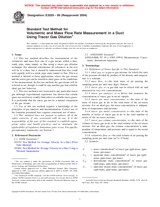Wir benötigen Ihre Einwilligung zur Verwendung der einzelnen Daten, damit Sie unter anderem Informationen zu Ihren Interessen einsehen können. Klicken Sie auf "OK", um Ihre Zustimmung zu erteilen.
ASTM E2029-99(2004)
Standard Test Method for Volumetric and Mass Flow Rate Measurement in a Duct Using Tracer Gas Dilution
Automatische name übersetzung:
Standard Test Method for Volumen- und Massendurchflussmessungin einem Kanal Mit Tracer Gas Dilution
NORM herausgegeben am 1.10.2004
Informationen über die Norm:
Bezeichnung normen: ASTM E2029-99(2004)
Anmerkung: UNGÜLTIG
Ausgabedatum normen: 1.10.2004
SKU: NS-44016
Zahl der Seiten: 10
Gewicht ca.: 30 g (0.07 Pfund)
Land: Amerikanische technische Norm
Kategorie: Technische Normen ASTM
Die Annotation des Normtextes ASTM E2029-99(2004) :
Keywords:
ducts, flow rate, mass flow, stacks, volumetric flow, tracer gas, ICS Number Code 13.040.01 (Air quality in general)
Ergänzende Informationen
| Significance and Use | ||||
|
The method presented here is a field method that may be used to determine mass and volume flow rates in ducts where flow conditions may be irregular and nonuniform. The gas flowing in the duct is considered to be an ideal gas. The method may be especially useful in those locations where conventional pitot tube or thermal anemometer velocity measurements are difficult or inappropriate due either to very low average flow velocity or the lack of a suitable run of duct upstream and downstream of the measurement location. This test method can produce the volumetric flow rate at standard conditions without the need to determine gas stream composition, temperature, and water vapor content. This test method is useful for determining mass or volumetric flow rates in HVAC ducts, fume hoods, vent stacks, and mine tunnels, as well as in performing model studies of pollution control devices. This test method is based on first principles (conservation of mass) and does not require engineering assumptions. This test method does not require the measurement of the area of the duct or stack. The test method does not require flow straightening. The test method is independent of flow conditions, such as angle, swirl, turbulence, reversals, and hence, does not require flow straightening. The dry volumetric airflow can be determined by drying the air samples without measuring the water vapor concentration. |
||||
| 1. Scope | ||||
|
1.1 This test method describes the measurement of the volumetric and mass flow rate of a gas stream within a duct, stack, pipe, mine tunnel, or flue using a tracer gas dilution technique. For editorial convenience all references in the text will be to a duct, but it should be understood that this could refer equally well to a stack, pipe, mine tunnel, or flue. This test method is limited to those applications where the gas stream and the tracer gas can be treated as ideal gases at the conditions of the measurement. In this test method, the gas stream will be referred as air, though it could be any other gas that exhibits ideal gas law behavior. 1.2 This test method is not restricted to any particular tracer gas although experimental experience has shown that certain gases are used more readily than others as suitable tracer gases. It is preferable that the tracer gas not be a natural component of the gas stream. 1.3 Use of this test method requires a knowledge of the principles of gas analysis and instrumentation. Correct use of the formulas presented here requires consistent use of units. 1.4 This standard does not purport to address all of the safety concerns, if any, associated with its use. It is the responsibility of the user of this standard to establish appropriate safety and health practices and to determine the applicability of regulatory limitations prior to use. For specific precautionary statements, see Section 7. |
||||
| 2. Referenced Documents | ||||
|
Empfehlungen:
EEviZak – alle Gesetze einschließlich ihrer Evidenz in einer Stelle
Bereitstellung von aktuellen Informationen über legislative Vorschriften in der Sammlung der Gesetze bis zum Jahr 1945.
Aktualisierung 2x pro Monat!
Brauchen Sie mehr Informationen? Sehen Sie sich diese Seite an.




 Cookies
Cookies
